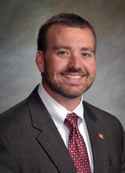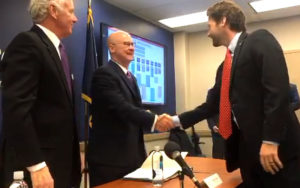
By Lindsay Street, Statehouse correspondent | A Charleston Democrat plans to file a bill in the next two weeks that conservationists say could be one of the best ways for the state to deal with nagging flooding issues.
The proposed bill would prevent future development in flood-prone areas, such as a 100-year flood plain.

“It will be filed,” S.C. Rep. Wendell Gilliard told Statehouse Report. He added the bill would be filed before the end of the month.
S.C. Environmental Law Project Executive Director Amy Armstrong called the proposal an “easy and seemingly obvious way to prevent future harm from flooding, and keep people and structures safe.”
The bill, still in its draft form, is similar to policy that the city of Charleston is already considering, according to city Chief Resilience Officer Mark Wilbert.
“We do not want to build in flood-prone areas at all. That just doesn’t make sense,” he said. “(But) there are a lot of questions of what that looks like. It’s a lot more complicated than what it appears on the surface … You can’t just wave a magic wand and tell everybody you can’t build here anymore. You have to do your homework.”
Wilbert said any policy must consider property owner rights in addition to the environmental or taxpayer cost.

Murrells Inlet Republican Sen. Stephen Goldfinch has filed another bill this year to help flood-prone property owners leave.
“People just shouldn’t be living in the hundred-year flood plain,” Goldfinch said, adding his bill has gained bipartisan support as the state deals with the triple threat of rising sea level, eroding coastlines and extreme precipitation leading to inland flooding.
“From a conservative right position, we continue to (federally) fund people whose homes have been flooded over and over and over again,” he said. “The taxpayers have literally repaired (some homes) five times and, at some point and time, you have to throw up your hands and say it’s not fiscally responsible and it’s almost morally reprehensible.”
Development continues
Meanwhile, development in the floodplain continues in South Carolina. One project that continues to be challenging is for development of Captain Sams Spit, a 175-acre barrier island outside of Charleston.
The S.C. Department of Health and Environmental Control issued permits in 2015 for creating a wall to stabilize a road leading to the barrier island, and water and sewer lines for a 50-home development there. The development has been in a legal tangle for at least a decade.

Armstrong, on behalf of the Coastal Conservation League, is challenging those permits. Late last year, an administrative judge stayed the permits while S.C. Environmental Law Project appeals them.
“Our barrier islands are the most vulnerable areas on the coast to storm damage, to flood damage,” Armstrong said. “They are the most susceptible to being overwashed when there are large weather events … (then) who’s left holding the bag to cleanup when those houses are destroyed and fall into the ocean? … It’s putting people and structures in harm’s way.”
Attempts to contact public relations at the developer, Kiawah Partners, were unsuccessful.
Nearby, the city of Charleston was fingered in 2018 for allowing more floodplain development than any other coastal city in the state.
- Weakening dam safety is also a concern for conservationists when it comes to flooding. Read more her
A more statewide view
While Charleston appears poised to shift policy as it takes the lead on many flooding issues in the state, some of its public servants have been tapped for the gubernatorial South Carolina Floodwater Commission.
Late last year, Charleston officials visited the Netherlands, a European country known for being below sea-level and its dykes used to keep its land dry.
“Water there is managed on a regional level,” Wilbert said of the big takeaway from the trip. “The governor’s commission is certainly a step in the right direction to look at this statewide.”

Commission Chairman Tom Mullikin of Camden said the commission is part of the state’s effort to take a holistic strategy to flooding. The commission will have a meeting Feb. 8 at Charlestown Landing State Park in Charleston. In December, the commission identified 10 task forces in its first-ever meeting.
“We are no longer treating extreme weather in South Carolina as an anomaly,” Mullikin said.
With the commission being so new, Mullikin said he cannot speak on any legislation currently, but he added that legislation will be one part of the commission’s future recommendations.
The 2019 session
Conservationists have lauded Goldfinch’s bill that will help homeowners take federal buyouts of their flood-prone property through establishment of a state fund.
“I was standing in knee deep sewage in someone’s house during the last major flood and I started talking to them and they told me what their problem was: They had been flooded twice before this and they wanted to go but they couldn’t get out,” the senator told Statehouse Report.
The Federal Emergency Management Agency offers loans to help homeowners leave flood-prone properties, but it requires a 25 percent match. Goldfinch’s bill would use federal money through a state program to offer a low-interest loan for that match. But the current bill would require local governments to make the application on behalf of a swath of homeowners.
“We are literally reclaiming wetlands where homes used to be,” Goldfinch said of the proposed revolving fund.

On Wednesday, a Senate subcommittee sent Goldfinch’s S. 259 to full Senate Agriculture and Natural Resources Committee. Chairman Paul Campbell confirmed the bill will be heard next week, but the meeting has not been posted online as of deadline for this publication.
Wilbert said another bill that can help ebb floodwaters in the state is one that allows a local sales tax to be used for floodwater mitigation. S.C. Sen. Marlon Kimpson, D-Charleston, introduced S. 217, which was given a positive report from the Senate Finance Committee this week. That puts the measure on the Senate calendar for a floor vote.
Wilbert said helping municipalities and counties access capital will be important in mitigating the triple-threat of water in the state.
- Have a comment? Send to: feedback@statehousereport.com



I-526 Extension Investment is Short-Sighted and Just Wrong for Our Future, January 19, 2019
FOR SURE WORRY
When a politician says don’t worry, I have a win-win deal for you, what should you do? Look up the meaning of oxymoron again.
In our emerging water-filled environment, the past does not predict the future. Nor should we be building a single public works project born of the past concept of an inland drier urban area, circled by an Interstate. Wrong place, wrong time, wrong policy. We need to address flooding in all its forms; river, surge and torrential downpours, for the long-term- starting now.
I-526X SCALE WRONG
Flood protection and the I-526 Extension connect in our pockets and pocketbooks. The $300 million plus interest and fees taken from all the county taxpayers for the I-526X that the Charleston County Council proposes to add to the state’s fixed $420 million is too risky because it ignores flooding needs that are unaddressed. The council majority was out-foxed again by its own inability to see, understand and respond to the flood threats; instead, focusing on a single highway to the exclusion of all the other clamoring needs; that this single highway investment will not address and if approved, will crowd them out.
The state SIB capped its total expenses and gave ALL Charleston County taxpayers the obligation to pay the difference no matter where they live. Our part of the deal is ALL of the unknown bottomless- overrun expenses, delay costs, unidentified field conditions, legal fees, change orders and corruption; plus, interest; that is shared by too few county taxpayers, benefitting far fewer; instead of the many. Interstates are funded at the state level and so should this one. What do county taxpayers inherit? You can guess but no one knows. But don’t worry. https://www.dropbox.com/s/3p3km7vm9yyoped/I-526X%24.pdf?dl=0
The county’s overall financial structure will require a major long-term borrowing or a lump sum capitalization of future transportation dedicated sales tax revenue in the capital budget; tolls to cross fund mass transit, that may later need to be combined with a mini version of congestion pricing to address what is the known remaining unmitigated congestion. Look away. Nothing to see or think about here.
THERE IS NO PLAN TO FIX FLOODING, ON A NEEDED SCALE, IN THE REQUIRED TIMEFRAME, TO ENGAGE THE EVER-RISING HIGH WATER!
The reason for the County Council to plan for and invest in flood protection first, over this big wide, too big, money-sucking Interstate highway: is that it takes longer and more money to build flood defenses, if we want to live here, and later sell appreciated in value housing. Lest there not be enough people to travel on the Interstate, on what will become a wasted public asset, as the value of housing assets near marshes, rivers and the ocean stalls or declines; as happens in other threatened communities. Because of insufficient attention of this county majority to also address the flood threat faced by the county’s cities and towns, through their misdirection of our scarce tax money, our financial risk is also raised.
The City of Charleston is staring at a $2 billion estimate and too little money available from residents to drain the city that has felt only the beginning of more water. Fix it or get swamped is the credo we need from our leaders. Worry about water and not about endorsing the I-526X. The single biggest contribution that Mayor Tecklenburg can make is to oppose this project and work with the governor and legislators, to get the State Infrastructure Bank to redirect a portion of the available $420 million to quickly fund flood infrastructure, including road raising and stormwater control so we can reside here and worry less. Every dollar spent, over what is needed to address egress traffic issues of the James and Johns Islands, is a dollar not spent on all the other needs. We have ignored the flooding 600 lb. gorilla for a decade and need a big leg up on it.
BE BRAVE
The Charleston County Council needs to establish a common framework to better coordinate with the plans of the City of Charleston, the surrounding coastal low country counties and the SC state, to produce a unified and coherent foundation strategy to address the common challenge – HIGH WATER.
Certainly, the Governor’s Flooding Commission recommendations will impact flood investments, highway design and placement and capital priorities in an integrated problem-solving framework, rather than the don’t worry, one-at-time issue takedown of this council majority.
The foundation of the Charleston County public investments and those around us, must rest on the water. The Charleston County officials will also need to examine the proposed highway placement (and other too low in the landscape roads) that is thought of as a raised highway; that may need to be placed- in the ground, bifurcated- to provide berms to channel water and siting- to protect higher ground. This large public investment can and must be made part of an effective response to the flooding, as advocated in the Dutch Dialogue development principals.
If we are going to build this thing, then it should do at least double duty and provide flood protection and carry traffic as part of a long-term integrated survival strategy of living with more water. The council majority needs to walk and chew gum. Whatever we have spent to date is water under the bridge. We should not use those large prior public expenditures to throw much more good money after bad. What may have been a good idea then, is becoming bad or unjustifiable as time goes on. We need to look to the future vision; not the past for inspiration.
DISPLACEMENT & STALL
Get ready for “woe is me” and “never let it happen again” or “we can’t afford it” stories as we miss our investment targets with a single vastly unproductive highway, (That will later be used to justify poor residential locations decisions to pay for it.), that will eat up directly or indirectly, most of our future financial capability. The county’s long-term funding sources from state and local budgets, grants and foundation awards will also be needed for flood protection, more connected highways, schools, raised roads, and so on; and to fund flood plans we have yet to express.
We have many plans and so many deferred projects beyond I-526X, to get done in a timely manner, to make livability our priority, that includes congestion that I-526X will never address. “The amount of time people sit in their cars when they can’t be at work or can’t be with their families is detrimental to the quality of life, and we want to get people to and from home and work safely.” is balderdash.
We also should not be isolated in high water, waiting for the flooding and tides to recede, disinfecting our wet poop-laden shoes, as the water table rises, thinking about what we will do in the face of next season’s storm forecasts and wondering if we should or can stay for the long haul.
Flooding is among priorities of the public interest that the council majority needs to address squarely before committing more investment into the I-526X project. If we say we don’t want to wait in traffic, then we will be waiting in the water. That water is not waiting; but rising annually. Actually, flooding investment needs to be planned out first before we seriously entertain this I-526X proposal.
Yes, it is complicated. We have one good shot to get the foundation flood policy right and some tweeks after. It needs our best. It needs to get done. We definitely should worry if it is not done well and timely.
DIG WE MUST
Herein lies an investigative story, as I-526X does not reduce congestion, but only displaces it. So why create what will be an expensive wasted asset, when more productive choices are passed over? This should not be about “winning” on a single issue by the council majority. It is about best for the community, and for whom and need; instead of the Clemson-like high-fiving council majority. Why? Why the myopic vision from this council majority? I don’t know.
Fred Palm
Related
Post & Courier Commentary, Charleston County I-526 completion is no threat to half-cent sales tax projects BY J. ELLIOTT SUMMEY, January 19, 2019
https://www.postandcourier.com/opinion/commentary/commentary-charleston-county-i–completion-is-no-threat-to/article_1a8fbde4-1b49-11e9-bb24-676aabb8942b.html
Post & Courier Letter, Using half-cent funds for I-526 risks future local projects, state credit rating BY LISA JONES-TURANSKY, January 19, 2019
https://www.postandcourier.com/opinion/commentary/using-half-cent-funds-for-i–risks-future-local/article_8dfb3004-1b50-11e9-88f0-0b91e43c8e19.html
Post & Courier Article, Here’s how more than $2.7 billion will be spent improving Charleston-area roads, January 16, 2019
https://www.postandcourier.com/news/here-s-how-more-than-billion-will-be-spent-improving/article_ab255c3e-1823-11e9-8bc3-57468ee169eb.html
Post & Courier Article, Isle of Palms faces millions in capital needs as leaders discuss tax increase, January 12, 2019. https://www.postandcourier.com/news/isle-of-palms-faces-millions-in-capital-needs-as-leaders/article_1d44817e-144f-11e9-a468-9f9a9110a313.html
Post & Courier Editorial I-526 could wreck other Charleston County needs, January 11, 2019 https://www.postandcourier.com/opinion/editorials/i–could-wreck-other-charleston-county-needs/article_df4dc138-151f-11e9-bdb3-1777d016079c.html
Post & Courier Article, State bank and Charleston County approve new deal to extend I-526, January 10, 2019 https://www.postandcourier.com/politics/state-bank-and-charleston-county-approve-new-deal-to-extend/article_4e04aa38-14e9-11e9-aba5-63f8d3549f74.html
Post & Courier Editorial, Those hoping 526 will fix Charleston traffic likely to be disappointed, December 31, 2018
https://www.postandcourier.com/opinion/editorials/editorial-those-hoping-will-fix-charleston-traffic-likely-to-be/article_9d9454e8-0942-11e9-a6c4-fb813672f402.htm